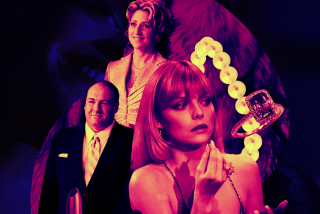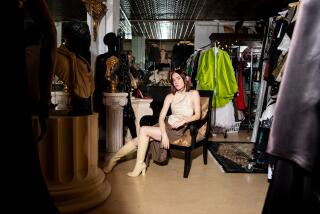Marilyn Minter willfully misfires glamour shots
Marilyn Minter’s latest pictures look like high fashion throwing up: Big, glossy close-ups of lipsticked mouths spewing diamonds, pearls and colorful, glittering goo.
Both luminous and grotesque, they are meant to evoke the experience of flipping through a glamour magazine like Vogue, Minter says.
“[People] get a lot of pleasure out of it, and at the very same time they know they’re never going to look that good,” she said. “So my aim is to try to create that same paradox. Because it’s a very complicated thing, the way we look, and what it feels like to look.”
Minter, 62, has worked largely under the radar for most of her 40-year career as a painter and photographer, but her more recent meditations on glamour have helped bring her to art world prominence. She had a solo show at the San Francisco Museum of Modern Art in 2005, and her work was seen in the 2006 Whitney Biennial (one of her pictures, of a woman’s cracked heels wedged into dirty stiletto pumps, was featured on the invitation to the exhibition).
Her newest works are on display at Regen Projects in Los Angeles through Dec. 5. The show includes several paintings and photographs of Pamela Anderson (without makeup, dripping wet and looking decidedly un-bombshell), as well as the pictures of made-up mouths smeared in goo. They came about when Minter asked a model to swirl a mixture of meringue and food coloring across a piece of glass with her tongue while Minter took pictures from below. An eight-minute video taken during that shoot, titled “Green Pink Caviar,” is playing once an hour on two high-definition billboards on Sunset Boulevard in conjunction with the show.
The art, Minter said, is meant to reveal the distance between representations of glamour in popular culture and the realities of the flesh.
Six feet tall, with red hair and bright red lipstick, Minter looks as if she could be a part of the fashion world she critiques. A former model who was, she said, once obsessed with her looks, Minter has long been preoccupied with ideas of glamour and beauty.
As a child growing up in Louisiana, she taught herself how to draw by sketching pictures of princesses and comic-strip heroine Brenda Starr. In her early 20s, while she was a student at the University of Florida, Minter made black-and-white photographs of her aging, pill-popping mother as the woman stared into mirrors and applied makeup.
“My mother was a textbook narcissist,” said Minter. But though her mother aspired to Hollywood standards of beauty, “her glamour was off,” Minter said.
The proof sheets of that photo series, now known as “Coral Ridge Towers,” caught the eye of Diane Arbus when the legendary photographer visited the school’s art department in 1969.
Arbus declared it the only student work she liked. But Minter said her peers ridiculed the work, and she left the film unprinted for 25 years.
Early subjects
After earning a master’s in fine arts from Syracuse University in 1976, Minter moved to New York City and set up shop in the SoHo studio where she lives today.
In the 1970s and 1980s, she made photo-realistic paintings that riffed on the representations of women and women’s work in popular culture. She made paintings of spills on kitchen floors and of images found in cookbooks and fashion magazines (often filtered through dot screens, à la Roy Lichtenstein).
In 1989, she began painting big, uncomfortably realistic paintings of hard-core pornography.
“I thought, ‘What subject matter have women artists never owned?’ ” she said. “I was interested in showing the construction of desire.”
Although the pictures led to several gallery shows in New York, they drew fire from anti-pornography crusaders and fellow artists who said that they weren’t critical enough and that they glamorized an industry which was demeaning toward women.
Minter worried that she would be forever exiled from the art world.
Back, then forward
But a turning point came in 1995, when she finally printed the “Coral Ridge Towers” photographs. She said they spurred her to pick up her camera again and begin making paintings based on her own photographs instead of found images.
Sometimes she presents the photograph as the work itself -- the Regen show includes several photos. For the paintings, Minter layers enamel on aluminum and paints the final layer with her fingertips to soften the image.
For the last decade or so, Minter has been making colorful, tightly framed pictures that mimic glossy fashion spreads and beauty advertisements -- except that in these pictures, like the photographs of her mother, something is off.
In a close-up of a woman’s eye, the glittery makeup is clumped and smeared. In a sensuous picture of an underarm, stubble can be seen sprouting from the skin. These are pictures of bodies that seek an idealized standard of beauty -- and fail.
The pictures appeal to audiences, Minter said, because they are honest.
“I think I might be hitting the zeitgeist,” she said. “All around you you’re looking at beautiful people that have been turned into robots. Maybe the eye is craving a little upper lip fur.”
While Minter’s work has gained respect in the art world -- she has had shows in England, Sweden, Spain and France, and the Museum of Modern Art in New York and the Museum of Contemporary Art in Los Angeles have both added her work to their collections -- it has also, ironically, been embraced by the world of fashion and beauty.
In recent years, Minter has shot pictures for Paper Magazine and Allure and has made advertisements for makeup companies.
Whenever she does commercial or editorial shoots, she works on her own projects in between takes. For example, she filmed “Green Pink Caviar” in the middle of a M.A.C. makeup shoot.
Minter calls herself “a parasite of the fashion world,” but the blurring of the line between her art and commercial work makes some audiences uncomfortable, said Joshua Shirkey, who curated Minter’s show at SFMoMA.
Shirkey pointed to a 2006 public art project that featured four of Minter’s photographs on billboards in New York City. The pictures, of gem-encrusted high heels kicking through dirty water, could have easily been mistaken for advertisements.
“We want to believe that art is separate from fashion and magazines,” he said. “What is difficult with her work is how close that edge is.” Minter is interesting, Shirkey said, because she avoids didactic readings of our visual culture.
“Instead of just rejecting it and saying, ‘This is evil and I want no part of this,’ she’s saying, ‘How does it work, why does it work, why does it have an affect on us?’ ”
Shirkey said Minter’s late-in-life success helps “make a case for letting ideas simmer.”
“In the art world there’s so much emphasis on ‘Who’s the next big thing?’ ” he said. “This whole system is driven by youth. But here’s a mature artist who is making the best work of her career.”
More to Read
The biggest entertainment stories
Get our big stories about Hollywood, film, television, music, arts, culture and more right in your inbox as soon as they publish.
You may occasionally receive promotional content from the Los Angeles Times.







